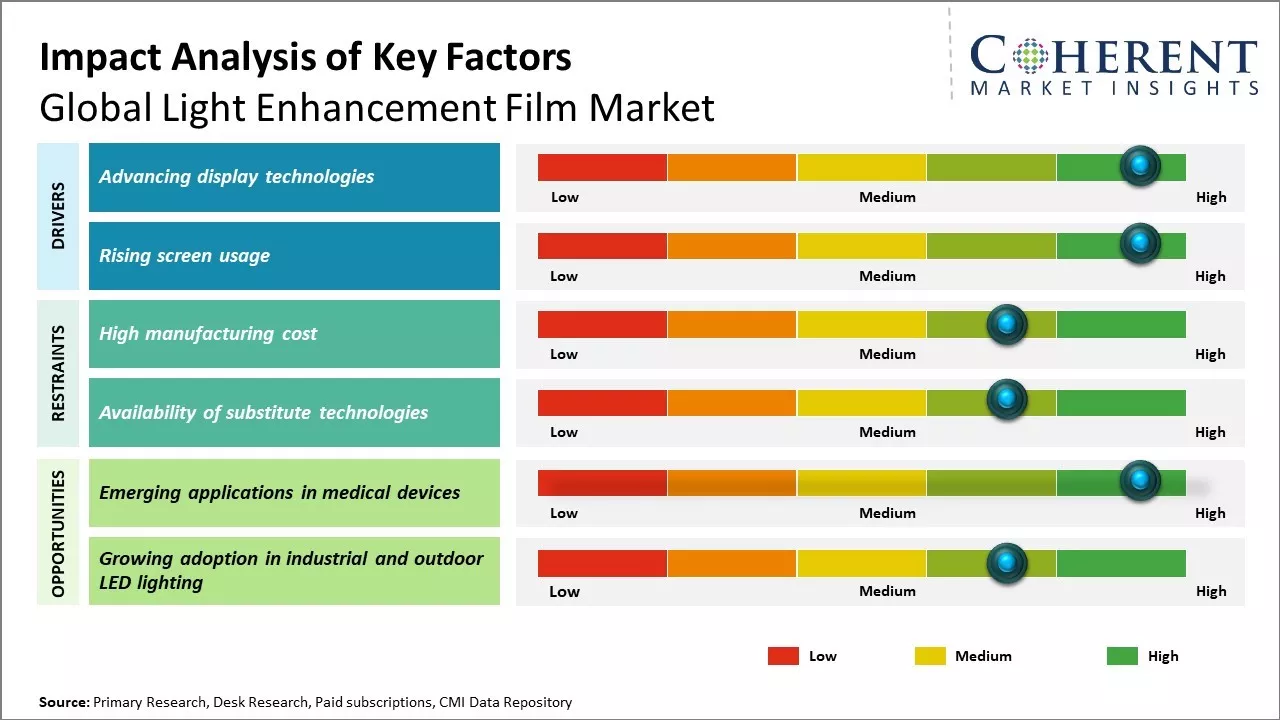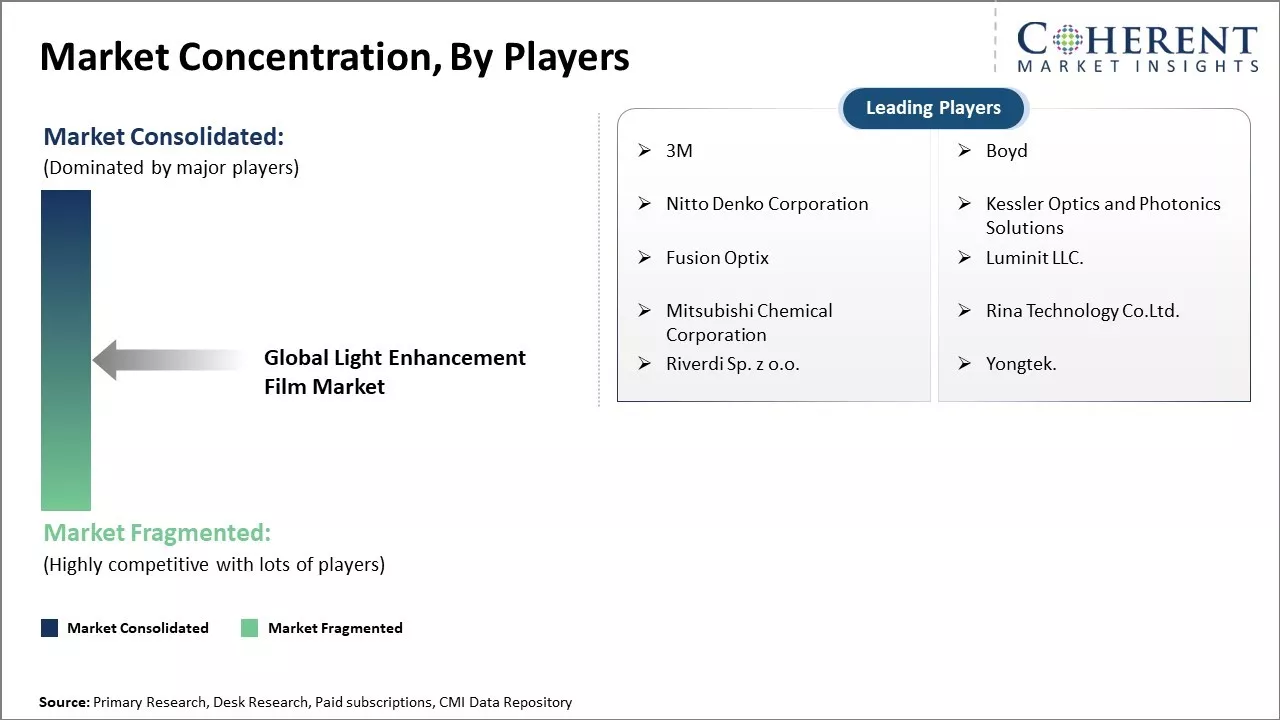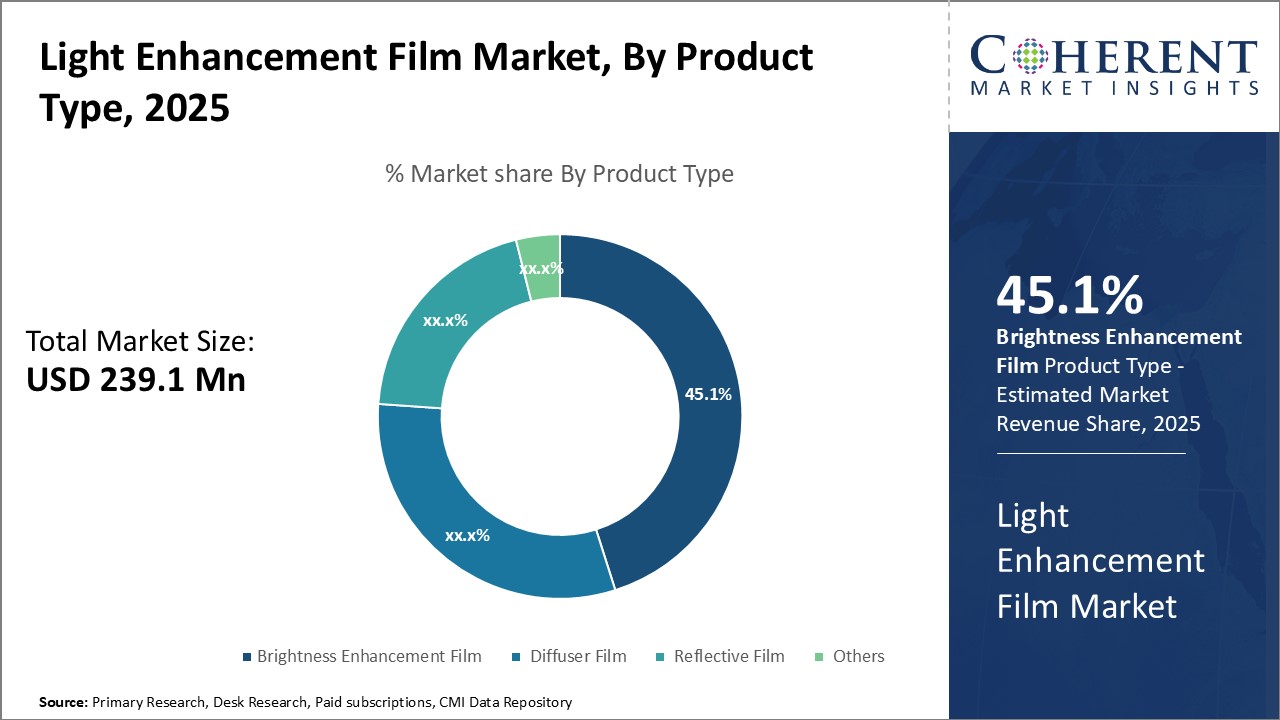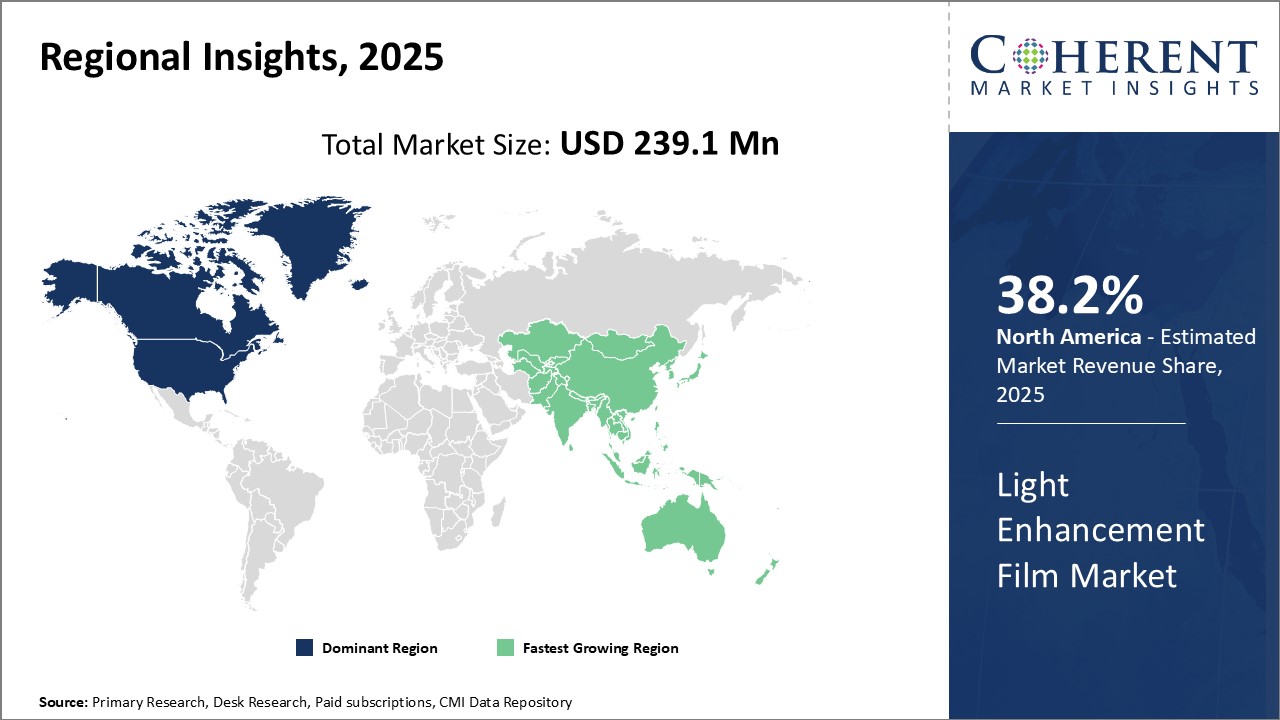Light Enhancement Film Market Size and Trends
The light enhancement film market is estimated to be valued at USD 239.1 Mn in 2025 and is expected to reach USD 404.8 Mn by 2032, exhibiting a compound annual growth rate (CAGR) of 7.8% from 2025 to 2032.

Discover market dynamics shaping the industry: Download Free Sample
The rising adoption of energy-efficient lighting solutions across various industries is driving the demand for light enhancement films. These films provide optimal light spread and assist in uniform lighting distribution. They help reduce glare and hot spots, thus enhancing visibility and readability. Additionally, the growing demand for transparent and flexible optical films from the consumer electronics industry for applications such as tablets, smartphones, and wearables is fueling the market growth. Various technological advancements in light enhancement film materials such as nanoparticles to boost light diffusion and microreplicated surfaces for enhanced brightness are further expected to support the market expansion over the next few years.
Advancing display technologies
The demand for light enhancement films is being driven significantly by the relentless advancements in display technologies across various industries. With customers increasingly expecting sharper, crisper, and more vivid visual experience from devices like smartphones, tablets, laptops, televisions, and digital signage, display manufacturers are focusing heavily on developing innovative display solutions. Light enhancement films have emerged as a core component of these evolving display technologies as they help boost brightness, reduce glare and reflections, and maximize contrast ratio to deliver enhanced optics.
Many smartphone makers have started incorporating ambient light sensors in recent years to automatically adjust display brightness based on the surrounding light conditions. However, even the brightest smartphone displays can be difficult to view under direct sunlight. This is where light enhancement films come into play by directing more light into the viewer's eyes. Their anti-reflective properties also reduce disturbances from ambient light for improved visibility. Not surprisingly, the universal shift towards bezel-less designs and edge-to-edge displays in premium smartphones has further increased the importance of optimizing every aspect of the visual experience, driving demand for superior light enhancement solutions.
Market Concentration and Competitive Landscape

Get actionable strategies to beat competition: Download Free Sample
Rising screen usage
The proliferation of internet-connected portable devices along with the ongoing digital transformation across industries has fueled explosive growth in screen time worldwide in recent years. On an average, people globally now spend over 7 hours staring at digital displays every day for activities like social media, online streaming, gaming, remote work, e-learning, and others. This astronomical rise in screen usage directly correlates to an elevated demand for enhanced viewing experiences.
Key Takeaways from Analyst:
The light enhancement film market has strong growth opportunities in the coming years. The rising demand for higher display quality in various consumer electronics such as smartphones, tablets, and TVs is a major driver for this market. As people spend more time on their devices, they expect better visual experience which is increasing the use of light enhancement films.
The North America region, , currently dominates the light enhancement film market and is expected to continue its leadership. This can be attributed to presence of large consumer electronics manufacturing base as well as several film manufacturers in the region. North America is projected to witness the highest growth and gain significant market share owing to growing TV replacement sales.
New developments in film materials, integration of multiple optical functions, and focus on high resolution and brightness levels will open more avenues for market players. Collaboration with display panel makers for customized products as per their requirements can provide advantages.
Market Challenges: High manufacturing cost
High manufacturing cost is one of the major factors restraining the growth of the light enhancement film market. Light enhancement films are used extensively in various display devices like laptops, smartphones, television screens, etc. to improve brightness, contrast, and visibility. However, manufacturing these films is a complex and expensive process. Light enhancement films are made up of multiple thin layers of different optical materials like acrylic adhesives, polarizing films and micro-replicated surfaces that are deposited precisely through advanced coating technologies like sputtering and vacuum deposition. Careful control over the thickness of each layer, ranging from few hundred nanometers to a few microns, is required to achieve the desired light manipulating properties. This makes the manufacturing equipment and tooling extremely costly. Moreover, each step involves handling ultra-thin and delicate materials under cleanroom environment which increases production costs significantly.
Market Opportunities: Emerging applications in medical devices
Emerging applications of light enhancement films in medical devices present a promising growth opportunity. Technologies like augmented reality and virtual reality are finding increasing applications in medical training and treatment. Light enhancement films can play a key role in improving display quality and enhancing the user experience of these emerging technologies. For example, some of the augmented reality applications being developed allow overlaying real-time medical scans and patients' condition on doctors' field of view through smart glasses. This gives important diagnostic information seamlessly during procedures or remote consultations without disrupting the workflow. Light enhancement films provide brighter, sharper and more uniform display in such smart glasses worn by doctors. This ensures critical medical details are visible clearly.

Discover high revenue pocket segments and roadmap to it: Download Free Sample
Insights by product type: Versatile applications across devices
In terms of product type, Brightness Enhancement Film (BEF) is expected to contribute 45.1% share of the market in 2025. Brightness enhancement film or BEF is widely used in a variety of electronic devices due to its ability to enhance the brightness and visibility of displays. BEF has partially aligned refractive structure that redirects light towards the viewer from LED backlights installed behind LCD panels. This helps in increasing brightness without consuming additional power.
The rising demand for larger, thinner, and brighter displays in consumer electronics and automobile infotainment systems is a major factor propelling the growth of BEF. Consumer preference for high quality viewing experience while watching content on mobile devices, computers, and TVs has boosted the adoption of BEF. Auto manufacturers are also incorporating advanced displays in cars for navigation, entertainment, and instrument panels which uses BEF to maximize visibility even in direct sunlight.
Developments in quantum dot and micro-LED displays that require highly efficient and affordable brightness boosters have further expanded the applications of BEF. Its compatibility with a wide range of curved screens and flexible displays is facilitating its use in newer form factors. Growing usage of high-resolution digital signage and smart displays in retail stores, offices and public places is also positively impacting the light enhancement film market market.
Insights by application: Rising screen sizes of consumer electronics and smart devices
In terms of application, Backlight Units (BLUs) is expected to contribute 30.2% share of the market in 2025. As the key light source component installed behind LCD/LED panels, backlight units or BLUs remain the largest application segment for light enhancement films. With consumers demanding bigger screens on smartphones, tablets, laptops and TVs, the backlight requirements of these devices have increased considerably. Larger screens need enhanced brightness and uniformity of light distribution across the display area which is effectively achieved through optimized BLU designs combined with light enhancing films.
The soaring popularity of ultra-high definition televisions with display diagonal size of 65 inches and above has boosted the demand for more powerful BLUs integrated with brightness improving films. Similarly, OLED screens penetrating the high-end smartphone and tablet segments are driving innovations in compact and narrow BLUs relying on film technologies. Automotive displays ranging from instrument clusters to sophisticated infotainment systems also depend heavily on efficient BLU systems to withstand vibrations and wide temperature ranges. Novel applications such as flexible displays, virtual/augmented reality devices, and smart wearables that employ micro-LED and mini-LED displays are opening new avenues for customized BLU solutions leveraging light enhancement films. Continuous developments in display and lighting technologies will further augment the prominence of BLUs as the major application field for optical films in the foreseeable future.
Regional Insights

Need a Different Region or Segment? Download Free Sample
North America has established itself as the dominant regional market for light enhancement films. The region is expected to account for 38.2% of the market share in 2025. The presence of key players in the region, such as 3M, LG Chem, and DuPont, has allowed North America to have early access to the latest technologies and product innovations in light enhancement films. Strong industrial and manufacturing sectors that demand high performance lighting and displays have also contributed to the growth of the region's market. Furthermore, countries like the U.S. have stringent regulations regarding energy efficiency in lighting which has favored the adoption of light enhancement films. The consumers in North America are also early technology adopters who are willing to pay premium prices for improved functionality, thereby allowing companies to price their products competitively in the region.
The Asia Pacific region has emerged as the fastest growing regional market for light enhancement films in recent years. Countries like China, Japan, South Korea, and India have witnessed tremendous industrial and infrastructural growth which has increased the demand for lighting and display solutions across various end-use industries. At the same time, the presence of a large number of domestic players in Asia Pacific has made light enhancement films easily accessible at competitive prices. Many international players have also established local manufacturing facilities in Asia Pacific to cater to the growing regional demand. Furthermore, governments in Asia Pacific are promoting energy efficient technologies through initiatives like Make in India and Made in China 2025, thereby incentivizing the adoption of light enhancement films. With growing domestic consumption and strengthening export potential, the Asia Pacific region is expected to dominate the light enhancement film market in the coming years.
Market Report Scope
Light Enhancement Film Market Report Coverage
| Report Coverage | Details | ||
|---|---|---|---|
| Base Year: | 2024 | Market Size in 2025: | USD 239.1 Mn |
| Historical Data for: | 2020 To 2024 | Forecast Period: | 2025 To 2032 |
| Forecast Period 2025 to 2032 CAGR: | 7.8% | 2032 Value Projection: | USD 404.8 Mn |
| Geographies covered: |
|
||
| Segments covered: |
|
||
| Companies covered: |
3M, Boyd, Nitto Denko Corporation, Kessler Optics and Photonics Solutions, Fusion Optix, Luminit LLC., Mitsubishi Chemical Corporation, Rina Technology Co.Ltd., Riverdi Sp. z o.o., and Yongtek. |
||
| Growth Drivers: |
|
||
| Restraints & Challenges: |
|
||
Uncover macros and micros vetted on 75+ parameters: Get instant access to report
Light Enhancement Film Industry News
- In 2020, LG Display, a leading innovator in display technologies, showcased its global leadership by introducing its latest displays and technologies at CES 2020 in Las Vegas, held from January 7 to 10. The event provided a platform for G Display to demonstrate cutting-edge advancements and innovations that are shaping the future of visual technology.
- In 2022, Efun Technology teamed up with RealD to develop innovative 3D cinema screens. This collaboration aimed to enhance the cinematic experience by leveraging advanced technology to create screens with superior reflectivity and brightness, catering to the growing demand for immersive 3D viewing in theaters.
*Definition: The light enhancement film market includes ultra-thin plastic films and coatings that are applied on surfaces to enhance visible light and improve light transmission. These films find applications in LCD panels, smartphones, tablets, and other consumer electronics to boost screen brightness and color quality without increasing power consumption. They offer higher optical clarity and reflectivity than standard films and help manufacturers create thinner and lighter electronic devices.
Market Segmentation
- Product Type Insights (Revenue, USD Mn, 2020 - 2032)
- Brightness Enhancement Film (BEF)
- Diffuser Film
- Reflective Film
- Others
- Application Insights (Revenue, USD Mn, 2020 - 2032)
- Backlight Units (BLUs)
- Televisions
- Laptops and Monitors
- Smartphones and Tablets
- Automotive Lighting
- General Lighting
- Others
- Regional Insights (Revenue, USD Mn, 2020 - 2032)
- North America
- U.S.
- Canada
- Latin America
- Brazil
- Argentina
- Mexico
- Rest of Latin America
- Europe
- Germany
- U.K.
- Spain
- France
- Italy
- Russia
- Rest of Europe
- Asia Pacific
- China
- India
- Japan
- Australia
- South Korea
- ASEAN
- Rest of Asia Pacific
- Middle East & Africa
- GCC Countries
- Israel
- Rest of Middle East & Africa
- North America
- Key Players Insights
- 3M
- Boyd
- Nitto Denko Corporation
- Kessler Optics and Photonics Solutions
- Fusion Optix
- Luminit LLC.
- Mitsubishi Chemical Corporation
- Rina Technology Co.Ltd.
- Riverdi Sp. z o.o.
- Yongtek.
Share
Share
About Author
Vidyesh Swar is a seasoned Consultant with a diverse background in market research and business consulting. With over 6 years of experience, Vidyesh has established a strong reputation for his proficiency in market estimations, supplier landscape analysis, and market share assessments for tailored research solution. Using his deep industry knowledge and analytical skills, he provides valuable insights and strategic recommendations, enabling clients to make informed decisions and navigate complex business landscapes.
Missing comfort of reading report in your local language? Find your preferred language :
Transform your Strategy with Exclusive Trending Reports :
Frequently Asked Questions
EXISTING CLIENTELE
Joining thousands of companies around the world committed to making the Excellent Business Solutions.
View All Our Clients
